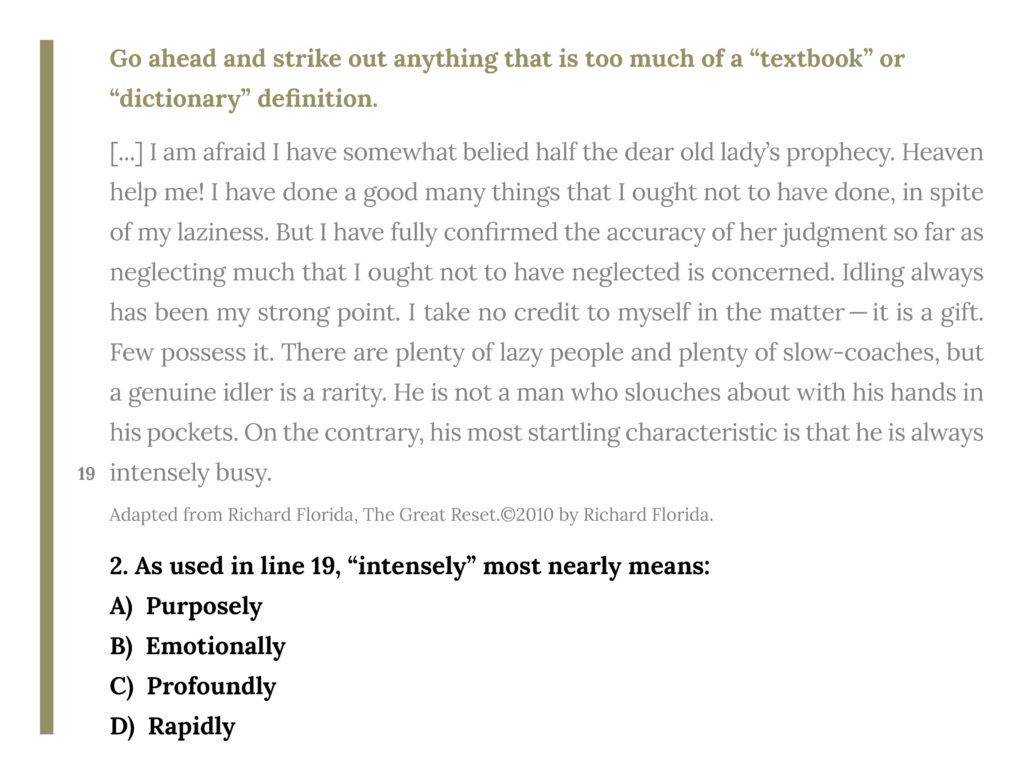So you’re going to take the SAT: whether it’s your first time or your fifteenth, our top strategies will help give you an edge on your next sitting. These are just some of the little nuggets of wisdom that our tutors and teachers pass on to Carnegie Prep students. Our strategies may seem simple, but given diligent practice, they are proven to increase your scores. Check out our suggestions and see if you are using each strategy to its ultimate advantage.
Coming in at 52 questions and 65 minutes, the SAT Reading section is the longest, most dense, and oftentimes most challenging section for students. On any given day, comprehension of these sometimes unwieldy, erudite passages can be difficult. Add a timed setting, a classroom full of anxious teenagers, and you’re facing a serious challenge. Never fear: we’ve compiled five of our most proven tangible strategies that are guaranteed to help you boost your scores and knock this section out of the park.
1. Best evidence: it’s better together
Answer the “Best Evidence” questions together. These question pairs tend to be the biggest challenge for students in the Reading section. You’ll have a much better chance of answering both of these questions correctly if you treat them in tandem. In other words, move to the Part 2 quotations first, identify which quotes pertain to the question in Part 1, and choose a pair of answers that work nicely together.
2. Pre-read the blurb and the questions
Think of it as a way of warming up your brain for the main event of the passage. Going into the reading having previewed the questions will make you a more attentive reader and keep you actively reading the whole way through. Important distinction: we are not suggesting that you answer the questions right away — just that you read them all. Doing so will give you an idea of not only what you’re about to read, but how you should read. Should you keep the main purpose in mind? The chronology? The relationship between characters, or passages themselves? All of this will make your actual reading much more efficient and your underlining more purposeful.
3. Vocab in context: use your words
If you master a strategy of attack, these predictable question types can easily become your friends. Remember that the test maker is asking you about the word “in context” or “in consideration of the way it is used in the sentence.” Consequently, in order to ensure we’re paying more attention to the context than the “dictionary” definition of the word, we recommend that you come up with your own synonym that makes sense in the passage, and find its best match among the answers.

The question type above is a common one. If we look closely, we’ll notice that all of these answer choices are distinct definitions of the word “intensely.” To match the context, we can choose a word of our own that would fit. Using the words around “intensely,” I might choose “very” or “tremendously.” Looking at the answers, “Profoundly” is the word that matches mine the best, so it must be the correct answer. Bubble away!
4. Don’t let the bright lights fool you
Have you ever seen an answer that just looks really good? One that seems it has to be right simply because it sounds so sophisticated or complex? Watch out! You may be stepping into a deliberately set trap. The test makers know which answer choices will look really good, really slick, and really tempting; they often capitalize on this by slipping a “landmine” into these answer choices, typically in the 2nd half of the option, to make the whole answer choice blow up. So SLOW DOWN. To these ends, your strategy should be to eliminate wrongness. Take your time to physically cross out anything that has problems. Then evaluate what remains. Remember, you aren’t necessarily looking for the “right answer” — you are looking for the least problematic one. This is why process of elimination is so vital on the SAT. You may say that you cross off answers in your head, but in our experience, students that take the time to physically eliminate bad choices, up their scores.
5. Find it interesting
We know you’ve probably read enough passages about the mysteries of penguin genetics, or the fascinating world of 19th century interstate commerce, or whatever the test maker sticks in passages to last a lifetime. But an amazing thing happens when you get interested in the subject of the reading passage — it gets easier. Ask yourself: what is fascinating about this topic? Does it have parallels or implications for aspects of my life? Or, do I know someone who would find this fascinating, and can I put myself in his/her/their shoes? An interested reader is an active reader, and an active reader is a high scorer. (Confused about active reading? Basically, it means not letting the text roll over you and knock you down. Paraphrase the meaning of each paragraph — even if you don’t understand the whole thing — silently before you move onto the next one. After you finish reading the entire passage, push yourself to summarize it in one line.)
Pro tip: Believe it or not, the passages chosen in the SAT Reading section are not picked for the sole purpose of confusing you. In fact, they are carefully selected as passages that should have some cultural, historical, or scientific relevance to you. The most prolific SAT Reading test takers are ones who can identify that relevance. Does this historical passage have any present-day implications? Does “the migration patterns of penguins” have any big-picture implications for evolution, or climate change, or any other science buzzword that you know about? Next time you take a practice SAT Reading section, ask yourself these questions — namely, why were these passages chosen — and watch your scores shoot up.


